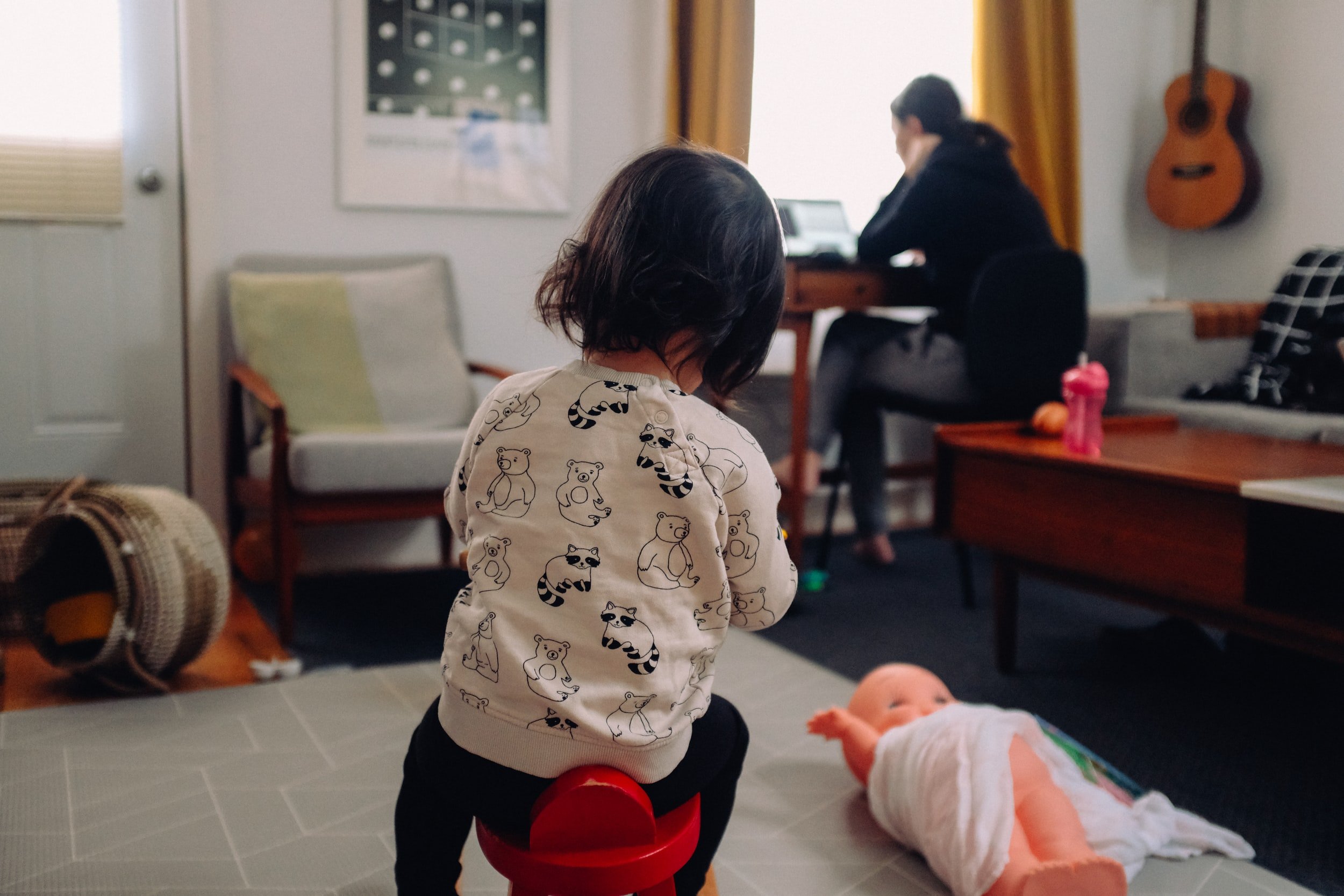I went back to work when my son was six months old and due to the pandemic, I have worked from home since, along with my partner. Our son is home with us, and we both work full time tech jobs without additional childcare.
I sometimes worry that my son is missing out but working together daily – my husband at his desk in our living room, my son on the floor in the playroom and me at my desk in the playroom – is working well for our family.
Through Rachael with Hey Sleepy Baby and other Instagram influencers, I learned a lot about biological norms for feeding and sleep, and through this network of educators that provide content that meshed well with my family’s values, I started to learn about play. When my husband and I started to think more critically about play as children’s work – meaning they learn and grow through play – it shifted our approach to our days and made our roles clear.
It is not our son’s job to fit his needs as a toddler around our work needs. It is our job as a family to create an environment where every one of us can be successful with our daily work. This means being deliberate to set ourselves and our child up with an environment that inspires work, being clear with each other about critical meetings and deadlines, and working together to manage when someone is having a hard time.
Tips for keeping it together and getting through the day
1. Mix it up. Using toy and book rotations has been instrumental in creating an engaging environment for play in our home. If your space and resources allow, it can be beneficial to further mix up your home’s play space through moving around furniture and making the space more dynamic. This can be as simple as moving a toy shelf to another area in your living room or storing toys in a different basket. Every other month I switch the location of my desk and my son’s toy shelf, and he plays completely differently in his space. We did this in our tiny apartment where two office spaces and a play space were in the same room, and we do it still in our home where we have a playroom right off our living room.
2. Add water or music. There are few meltdowns – from myself or my toddler (or his younger self) – that cannot be solved by a drink of water, playing in water, or adding music to the background. When our son is having a hard time and we need to get to work, taking a break to recognize his body may need a drink, to get outside or to move, is instrumental in resetting.
3. Designate focus time. One of the most profound shifts I’ve made is my approach to time in the workday. What pre-baby me viewed as my employer’s time, post-baby me views as my time. Your time is yours. It is one of the only things in life you can never get back. Be deliberate about it. I like to front load my day by designating one or two hours each morning where I am free from meetings and can reply to email thoughtfully – this also happens to be when my son is most content playing independently. I use this time to get through as many tasks as humanly possible. Each night, I map out my focus time for the next day, adjusting priorities based on the latest updates from my day. This empowers me to start the day strategically.
4. Take out a “time loan.” I first heard the term “time loans” from @kids.eat.in.color and it resonated with me. The basic thinking is to embrace mess. By allowing young children to play without boundaries in how they play and letting them really get into their work with toys, craft supplies, etc. we empower them to spend more time on a task and forgo our expectations. This creative freedom allows parent’s time for other activities like work. An activity that generates a period of self-guided play may only take a few minutes to clean up. An alternative way to think about time loans and one of my favorites is the contact nap. My son wouldn’t nap alone until he was nearly one. By laying with him while he napped during the workday, I was able to leverage that time for strategic work and planning.
4. Embrace the reset. A firm schedule can be really attractive to balancing work and parenting, but I’ve found that attempting to stick to rigid timetables drives me insane. The nap reset is one of my favorite lessons from Rachael – at its simplest, if your child isn’t falling asleep after 15 or so minutes, take a break and try again in a bit. We used this often when my son was an infant, and still occasionally as a toddler. By embracing the reset, I am able to get back to work more quickly than when trying to get him to sleep when he just isn’t ready.
Some balls are glass, some balls are plastic
Regarding all of the juggling involved in parenting, Nora Roberts famously said “some of the balls you have in the air are made of plastic and some are made of glass.” The most profound lesson I have learned returning to work as a parent, is that having a firm grasp on what things are glass makes getting through the workday with a child home much easier.
If my son is having a hard time, pulling on my hand or, when he was younger, only happy in my arms nursing, this is glass. Leaving the email I am writing to connect with him for 10-minutes, means I am filling his cup and can much more quickly get back to my plastic tasks. BUT, if that work item I am focused on has a pressing deadline or I have an important meeting, then it’s bigger and more fragile, and I’ll pull in support from my partner or turn on a quality show (favorites include Bluey, Trash Truck, If You Give a Mouse a Cookie, or Bug Diaries).
Any time with the TV really impacts my son’s behavior, so we prioritize setting our work from home environment and routine up to ensure all of us can be successful with our daily work.
Finally, some days are just ok, and I end them not feeling great about my work or about my parenting. Tomorrow is a new day. Returning to work after leave can require a learning curve as expectations for yourself as a parent and professional shift. It’s ok if you just get through.
Was This Helpful? Save It For Later!








